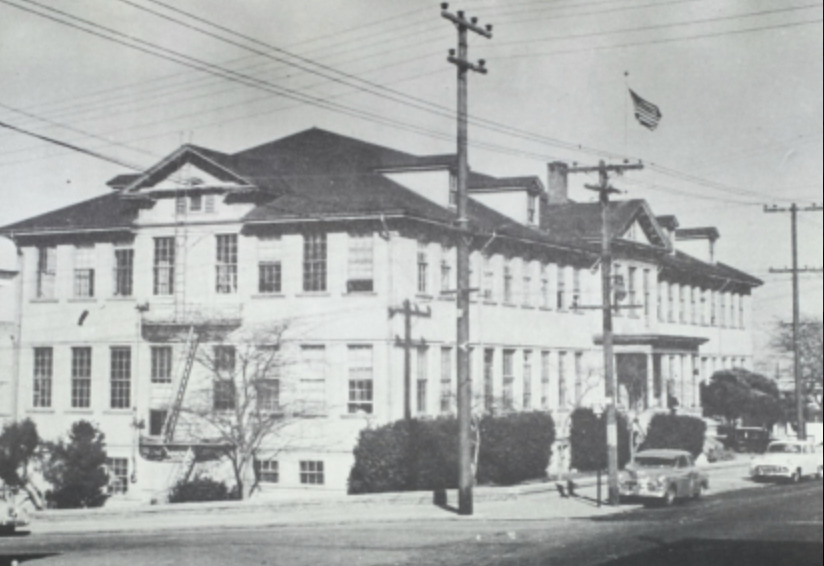
Courtesy of the LWHS Archives
Lick-Wilmerding’s class of 1955 was the first senior class that graduated from the 755 Ocean Avenue campus. Prior to 1955, the LWHS campus was at 15th and Utah Street, in a flat, industrial area between the Mission and Potrero Hill. The original building for Lick’s California School of the Mechanical Arts was built in 1894 and opened on January 3, 1895. Within a few years, the buildings of the
In 1955 the now combined Lick and Wilmerding Schools moved as Lick-Wilmerding High School to the current site of the school at 755 Ocean Avenue.
Ken Sproul ’56 experienced the transition to the new campus. During his time at LWHS, Sproul was student body president and continues to plan reunions for his high school class.
Sproul explained LWHS’ old neighborhood and the surrounding communities: “There were only industrial buildings. We were surrounded by working factories, warehouses, and repair depots, so it was a pretty gritty neighborhood —with the exception of Seal Stadium, the old ballpark, which was a block and a half away.”
“If you think the old Ocean campus was bad (the building that was torn down in 2018 and replaced by the current Ocean Avenue building), you should have seen the old Potrero campus,” said Sproul. The old campus was a three-story building and was an entire city block. Half of the block was an abandoned brick building. The other half was the actual school and the gym.
There was a basement level where the shops were, along with the locker room. The first floor was classrooms, with some more shops. The second and third floors held more academic classrooms and the library.
The old campus was in really bad conditions. If you played sports, the shower room was horrible,” said Sproul.
Student Life shifted with the move to the Ocean Avenue campus. Sproul said, “When I started LWHS as a freshman, almost the majority of the guys in the senior class were shop students. When I left, the shop students were a minority. It was just the whole shift of the school.”
After World War II, LWHS had decided to begin the transition from being a trade school to an academic college prep school over a period of about five or six years. Prior to the war, being an independent tradesman was a very successful business. However, after the war, society shifted to focus more on technical knowledge and academics.
Students at LWHS played a major role in the move from the old campus to the new one. During the summer of 1955, the students drove pickup trucks with furniture and school materials from building to building.
Another major change that occurred other than the physical location and curricular focus was the size of the student body. Sproul said, “the incoming freshman class at the new school was almost twice the size of my graduating class. So the population of the school almost doubled”.
Ed Rich was a pivotal figure in the history of LWHS. Before becoming head of school at LWHS in 1955, he was headmaster at Town School for Boys. He was hired solely to shift LWHS culture from being a trade school to becoming an academic college prep institution. Rich asked that half of the graduating class of Town come with him to LWHS or he would not leave, so half of that class trusted Rich and followed his lead to Lick-Wilmerding High School.
Rich became famous, not only for his leadership of the school but also for his English class. He wrote his own grammar book.
Transitioning to the new campus was difficult. Sproul said, “In my freshman class, we really had three groups of people. We had the guys who were still shop majors. We had the kids from Town school, who had a better education and were better prepared academically than most of us, and we had the guys from public schools.”
“I remember the shop guys who had been there and all of us newbies standing on separate sides of the field. The shop guys started picking up little pieces of the broken asphalt and it was thrown back and forth. There was a lot of friction for about two weeks,” said Sproul. Eventually, there were amends between the groups. Sproul said, “We needed them to show us how to do machine shop, metal shop, woodshop, and they needed us to help them with their math. The tension melted away within six weeks, eight weeks.”
Sproul said the members of his class were very proprietorial of the new building. During his time. he said the whole school was kept clean by the students. Students would work after school by cleaning up the campus for the next school day. Students consciously wanted to keep the campus clean and they didn’t want their friends picking up after them.
Sproul said when they moved into the Ocean Avene campus, a whole bunch of new teachers were hired for art, English, foreign language, and science labs.
Sproul remembers that if you were over 17, had good grades, and had a note from your parents that gave you permission to smoke, you were allowed in the smoke room. Sproul said, “You have to remember, LWHS was an all-boys school in the 1950s, so we all smoked, everybody smoked.” The smoke room was a quarter of the gym and up a ladder to a mechanical space that housed the air conditioning and ventilation units for the gym. Students brought old furniture to make it feel like home.
Lunch had been non-existent at the old campus. Students would bring lunch from home or go out and buy food from local vendors. At the new campus, the cafeteria was very important to students.
It was mandatory to take classes in the four shops: electric, machine shop, woodshop, and metal shop. “We also did mechanical drawing, mechanical drawing was critical.”
However, the shops classes were no longer the first priority. Sproul said, “The move was a major pivot point for LWHS, the culture, building, and student body were all different.”
LWHS, as we know it today, was formed during the transition. The modern school is rooted in the vision of George Merrill and the three founders’ concept of industrial education, but LWHS would not be one of the most elite high schools in our area if it was not for Rich — and the hard work of the class of ’56.







